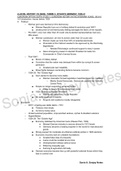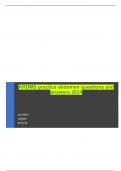Other
Cambridge A-Level History (9489) Paper 4: Hitler's Germany, 1929-41 Notes
- Course
- Institution
A* standard notes for Cambridge A-Level History (9389/9489) Paper 4 European option, Depth Study 1: European history in the interwar years, 1919–41 covering Theme 3: Hitler's Germany (1929-41). Includes essay outlines, mind maps, and exam tips. I achieved an A* for History in the Cambridge A-L...
[Show more]




